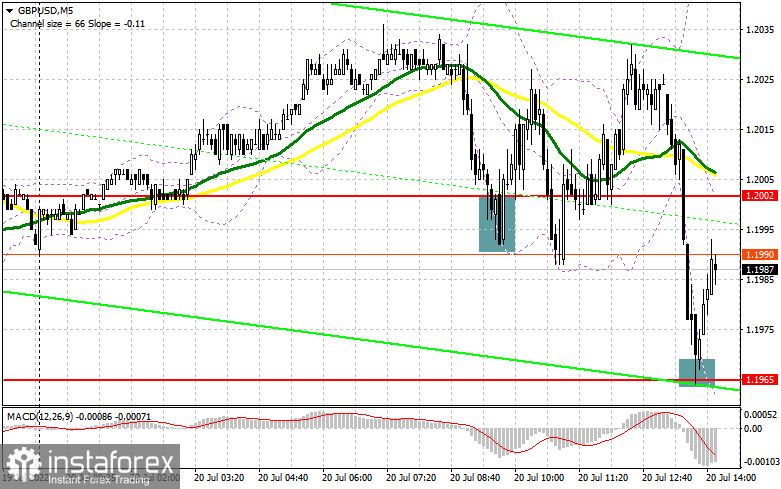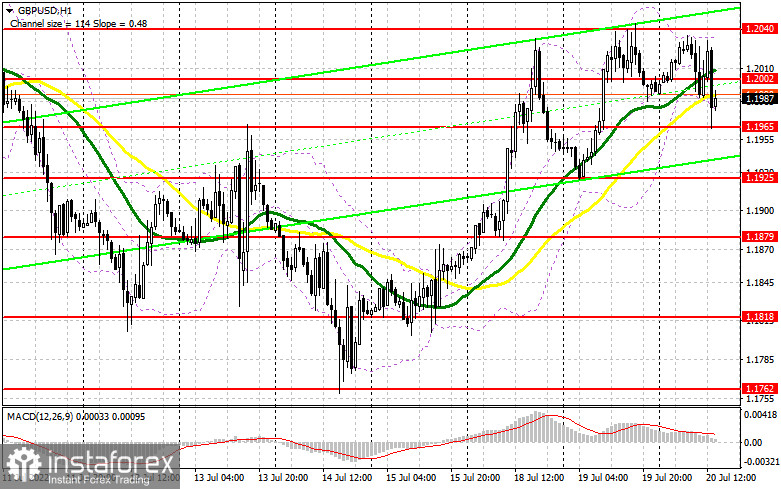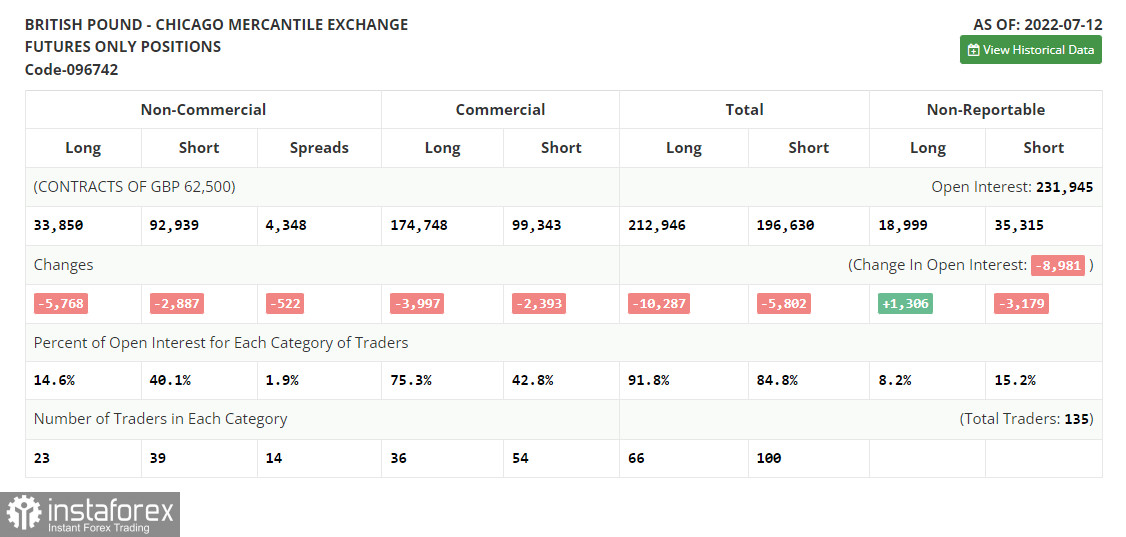In my morning article, I focused on the level of 1.2002 and recommended making decisions to enter the market, taking it into account. Let's observe the 5-minute chart and analyze it. The pound's decline after the release of inflation data and the formation of a failed break at 1.2002 resulted in a clear buy signal. Consequently, the pair rose by nearly 30 pips with no further movements. The retest of the level of 1.2002 lead to the breakout and dramatic decline of the pair to 1.1965, where a similar breakout gave a signal to open new long positions. At the moment of writing, the rise from the entry point was about 30 pips. Some aspects have changed in the afternoon from the technical point of view.

To open long positions on GBP/USD, you need:
Yesterday's data shows that UK inflation hit a new 40-year high in June 2022. This aggravated the cost of living crisis and forced the Bank of England to further raise interest rates more sharply. Consumer prices rose by 9.4% compared to last year. It is considered the biggest increase since February 1982. The Office for National Statistics noted that fuel prices had surged by 9.3% in June. However, the pound's morning downward movement ended near the support at 1.1965, which I had mentioned. I recommend focusing on it in the afternoon. Moreover, it is advisable to take into account US existing home sales data and mortgage refinancing index, though they will unlikely strengthen US dollar positions significantly. Strong reports will definitely lead to a new decline of the British pound. The best option is to buy the pair after its failed break at the low of the day around 1.1965, which is a clear signal to open long positions with the target of return to 1.2002. That level is of extremely significant, so buyers will try to close the day above that range. A breakout of 1.2002 and a reversed top-down test will create a more powerful ascending momentum, which gives a buy signal with a jump target to 1.2040, which the pair failed to reach in the morning. A similar breakout of this level will give a chance to reach 1.2081 and 1.2119, where I recommend locking in profits. The area of 1.2160 will become a more distant target. The pair's fall and absence of buyers at 1.1965 will be the reason for increasing pressure on the pound. Therefore, I recommend not to open long positions before the pair reaches 1.1925. I recommend buying the pair only in case of failed break. It is possible to open long positions on GBP/USD immediately on a rebound from 1.1879, or even lower around 1.1818, with a target of 30-35 pips intraday correction.
To open short positions on GBP/USD, you need:
Investors focused on sharp sales of the pair. This is common under the current market conditions. The best option to open short positions is a failed break of the nearest resistance at 1.2002, which was formed during the first half of the day. Strong US data will return pressure on the pair with the target to decline to the intermediate support at 1.1965. In case bulls are not active at this level and the GBP/USD pair consolidates lower, a reverse bottom-up test will give an additional entry point to sell the pound, with the fall to 1.1925, where I recommend locking in profits partially. The area of 1.1879 will be a more distant target. In case of further growth of GBP/USD and absence of bears at 1.2002, buyers will further control the situation. In this case, I advise traders not to sell the pair. Only a failed break near the weekly high at 1.2040 will provide an entry point to short positions, counting on the pair's downward rebound. If traders show no activity there, another upward surge will be likely. If this case, I recommend not to open short positions to 1.2081 and 1.2119, where it is possible to sell the GBP/USD pair immediately on the rebound, counting on the pair's downward rebound by 30-35 pips within a day.

The COT report for July 12 recorded a reduction in both short and long positions. However, short positions were much more numerous, which led to a rise in the negative delta. Another attempt to buy the annual low failed again, though traders began to lock in profits by the end of the week due to strong US statistics, which led to a slight pound's correction. The cost-of-living crisis in the UK continues to escalate. However, the UK government has failed to resolve it so far. At the same time, the Federal Reserve's policy and the pace of US interest rate hikes by nearly 1% provide more support to the dollar, pushing the pound lower. The COT report showed that long non-commercial positions fell by 5,768 to 33,850, while short non-commercial positions declined by 2,887 to 92,939. This resulted in an increase of the negative non-commercial net position to -59,089 from -56,208. The weekly closing price decreased to 1.1915 versus 1.1965.

Indicator Signals:
Moving averages
Trading is conducted around the 30 and 50-day moving averages, indicating further market uncertainty with growth.
Note. The period and prices of moving averages are considered by the author on hourly chart H1 and differ from the common definition of classic daily moving averages on daily chart D1.
Bollinger Bands
In case of decline, the middle boundary of the indicator around 1.1970 will act as support.
Description of indicators
- Moving average (moving average determines the current trend by smoothing out volatility and noise). Period 50. It is marked in yellow on the chart;
- Moving average (moving average determines the current trend by smoothing out volatility and noise). Period 30. It is marked in green on the chart;
- MACD (Moving Average Convergence/Divergence - moving average convergence/divergence) Fast EMA period 12. Slow EMA period 26. SMA period 9;
- Bollinger Bands (Bollinger Bands). Period 20;
- Non-commercial traders are speculators, such as individual traders, hedge funds and large institutions, which use the futures market for speculative purposes and meet certain requirements;
- Long non-commercial positions represent the total long open position of non-commercial traders;
- Short non-commercial positions represent the total short open position of non-commercial traders;
- Total non-commercial net position is the difference between short and long positions of non-commercial traders.





















